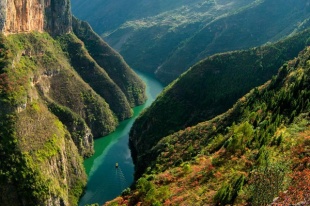South China Karst


Category of Site: Natural site
Brief introduction
The huge karst area of South China is about 550,000 square kilometers in size. The karst terrain displays a geomorphic transition as the terrain gradually descends about 2000 meters over 700 kilometers from the western Yunnan-Guizhou Plateau (averaging 2100 meters elevation) to the eastern Guangxi Basin (averaging 110 meters elevation). Spreading over the provinces of Guizhou, Guangxi, Yunnan and Chongqing and covering 176,228 hectares, the region is recognized as the world's typical area for karst landform development in the humid tropics and subtropics.
The World Heritage Property of South China Karst is a series of sites including seven karst clusters: Shilin Karst, Libo Karst, Wulong Karst, Guilin Karst, Shibing Karst, Jinfoshan Karst and Huanjiang Karst. The total area encompasses 97,125 hectares, with a buffer zone of 176,228 hectares.
The property was inscribed in two phases. It was first inscribed on UNESCO's World Heritage List as a natural property in 2007, focusing on three sites. In 2014, another three were added to the list.
Natural heritage
The South China Karst World Heritage site includes spectacular karst features and landscapes which are both exceptional phenomena and of outstanding aesthetic quality. It includes the stone forests of Shilin, natural phenomena which include the Naigu stone forest occurring on dolomitic limestone and the Suyishan stone forest arising from a lake. Also of note are the remarkable Fengcong and Fenglin karsts of Libo, and the Wulong Karst which includes giant collapse depressions called Tiankeng, and exceptionally high natural bridges between them, with long stretches of deep unroofed caves.
It also takes in Guilin which has a spectacular tower karst and internationally acclaimed Fenglin riverine landscapes, Shibing Karst, which has the best known example of subtropical Fengcong Karst in dolomite, deep gorges and spine-like hills often draped with cloud and mist, and Jinfoshan Karst, which is an isolated island long detached from the Yunnan-Guizhou plateau, surrounded by precipitous cliffs and punctured by ancient caves. Huanjiang Karst provides a natural extension to Libo Karst, contains outstanding Fengcong features and is covered in almost pristine monsoon forest.
The property's forest cover and natural vegetation is mainly intact, providing seasonal variation to the landscape and further enhancing the property's very high aesthetic value. Intact forest cover also provides important habitat for rare and endangered species, and several components are of great biodiversity conservation value.
The South China Karst World Heritage property reveals the complex evolutionary history of one of the world's most outstanding landscapes. Shilin and Libo are global reference areas for the karst features and landscapes that they exhibit. The stone forests of Shilin developed over 270 million years during four major geological time periods from the Permian to present, illustrating the episodic nature of the evolution of these karst features. Libo contains carbonate outcrops of different ages shaped over millions of years by erosive processes into impressive Fengcong and Fenglin karsts. Libo also contains a combination of numerous tall karst peaks, deep dolines, sinking streams and long river caves. Wulong represents high inland karst plateaus that have experienced considerable uplift, with giant dolines and bridges. Wulong's landscapes contain evidence for the history of one of the world's great river systems, the Yangtze and its tributaries. Huanjiang Karst is an extension of the Libo Karst component. Together the two sites provide an outstanding example of Fengcong karst and also preserve and display a rich diversity of surface and underground karst features.
What is karst
Distinctive associations of third-order, erosional landforms indented into second-order structural forms such as plains and plateaus. They are produced by aqueous dissolution, either acting alone or in conjunction with (and as the trigger for) other erosion processes. Karst is largely restricted to the most soluble rocks which are salt, gypsum and anhydrite, and limestone and dolostone.
The essence of the karst dynamic system is that meteoric water (rain or snow) is routed underground because the rocks are soluble, rather than flowing off in surface river channels. It follows that caves develop in fracture systems, resurging as springs at the margins of the soluble rocks or in the lowest places. A consequence is that most karst topography is 'swallowing topography', assemblages of landforms created to deliver meteoric water down to the caves.





































